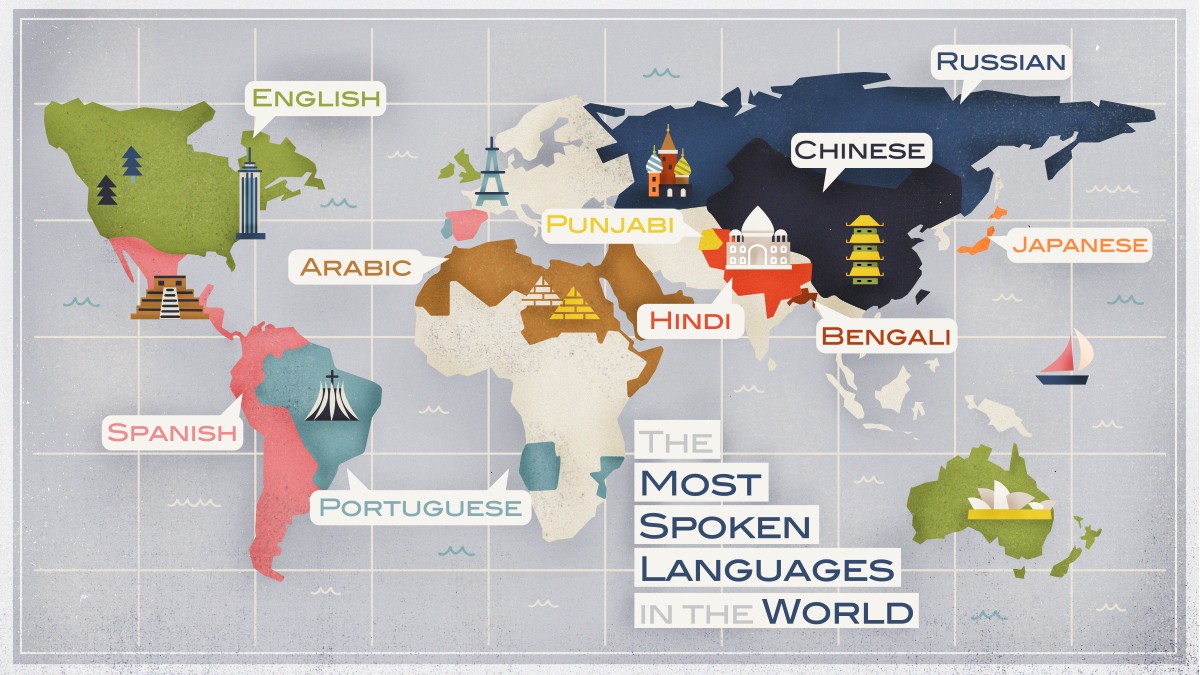Determining the world’s most widely spoken language is more complex than it initially appears. While names like Mandarin, English, and Spanish often come to mind, the true picture involves nuances in definition and data interpretation. It might surprise you to learn that languages like Bengali also rank among the top ten. Pinpointing exact figures for native speakers is challenging due to varying definitions of “language” versus “dialect” and the reliability of data collection across different sources and times. For instance, what we call “Chinese” encompasses a family of languages, and “Hindi” serves as an umbrella term for numerous dialects. Data compiled by Ethnologue, a widely respected source for language statistics, offers valuable insights, but understanding the complexities behind these numbers is key to truly grasping the global linguistic landscape. So, let’s delve into the fascinating world of language statistics and uncover which languages truly dominate global communication.
Top 10 Languages By Number Of Native Speakers
When considering only native speakers, a clearer hierarchy of the world’s most spoken languages emerges, highlighting the languages with the largest populations of mother-tongue speakers.
1. Chinese — 1.3 Billion Native Speakers
Chinese undoubtedly claims the top spot as the most spoken language globally when counting native speakers. Ethnologue estimates around 1.3 billion native speakers, with approximately 900 million speaking Mandarin. This means roughly one in six people worldwide are native Chinese speakers. For those looking to learn a language with vast global reach, Chinese presents an unparalleled opportunity. However, be prepared for a linguistic adventure: Chinese is a tonal language employing thousands of logograms, offering a significant learning curve for many.
2. Spanish — 486 Million Native Speakers
Spanish secures the second position when ranked by native speakers, boasting approximately 486 million speakers. This places it ahead of English in native speaker numbers. Spanish is your language of choice if you aim to unlock communication across entire continents. It serves as the primary language throughout most of South and Central America, Spain, and significantly in parts of the United States. It’s important to remember that language and identity are intertwined and often politically charged. For example, speakers of Catalan or Quechua may have different perspectives on the prominence of Spanish in their regions.
3. English — 380 Million Native Speakers
If you are reading this, you are likely among the estimated 380 million native English speakers, or perhaps one of the billion who speak it as a second language. English’s global prominence as the lingua franca of international business, travel, and diplomacy is undeniable. Its status as the most common official language globally further cements its reach. The relative ease of learning English compared to languages like Chinese, coupled with the pervasive influence of U.S. culture, suggests English will maintain its global dominance for the foreseeable future. For many, English continues to represent opportunity and a path to an improved quality of life.
4. Arabic — 362 Million Native Speakers
Arabic is estimated to have around 362 million native speakers. However, similar to Chinese, these figures mask the linguistic diversity within Arabic. Arabic encompasses numerous dialects so distinct they could be considered separate languages. Modern Standard Arabic serves primarily as a written form, rooted in Classical Arabic, the language of the Quran. In contrast, spoken Arabic dialects vary considerably. For instance, the Arabic spoken in Oman and Morocco differ so significantly that speakers from these regions might find it challenging to converse casually, despite sharing a literary language.
5. Hindi — 345 Million Native Speakers
India recognizes 23 official languages, with Hindi and Urdu being primary among them. The classification of Hindi and Urdu as either one language (Hindustani) with different dialects or two distinct languages remains debated. Hindi, primarily spoken in northern India and parts of Pakistan, employs the Devanagari script, while Urdu uses Persian script. Traveling through the Indian subcontinent, even basic Hindi can be incredibly useful. Interestingly, Hindi has contributed words like “shampoo,” “jungle,” “jodhpurs,” and “bungalow” to the English lexicon.
6. Bengali — 237 Million Native Speakers
Bengali’s inclusion in the top ten most spoken languages might come as a surprise to some. The 1947 Partition of Bengal by the British Empire separated West Bengal, now part of India, from East Bengal, which became Bangladesh. Bengali is the language of Kolkata, the Andaman Islands, and Bangladesh, home to over 130 million people. Bangladesh is particularly vulnerable to climate change, with projections indicating a population doubling in the coming century while 15% of its land area is expected to be submerged by rising sea levels.
7. Portuguese — 236 Million Native Speakers
Portuguese owes much of its global reach to its colonial history. Beginning in the 15th century, Portuguese explorers and traders spread their language across Africa, Asia, and the Americas. While its initial expansion was linked to colonization, Portuguese evolved in colonized countries, developing unique cultural expressions. Today, approximately 236 million native speakers reside in countries like Brazil, Angola, Mozambique, Cape Verde, Guinea-Bissau, and São Tomé and Príncipe. Portuguese is also the language of renowned literary figures like Machado de Assis and Mia Couto, and musical styles like Bossa Nova.
8. Russian — 148 Million Native Speakers
Russian, with around 148 million native speakers, ranks as the eighth most spoken language by this metric. Known for its complex grammar and the beautiful Cyrillic script, Russian is one of the six official languages of the United Nations. It boasts a rich literary heritage, having produced literary giants such as Dostoyevsky, Tolstoy, and Chekhov.
9. Japanese — 123 Million Native Speakers
Almost all of the 123 million native Japanese speakers reside in Japan, making it the most geographically concentrated language on this list. Japanese utilizes three writing systems: hiragana, katakana, and kanji (Chinese characters). Outside Japan, significant Japanese-speaking communities can be found in the United States, the Philippines, and Brazil.
10. Lahnda (Western Punjabi) — 118 Million Native Speakers
Rounding out the top ten is Lahnda, also known as Western Punjabi, a macrolanguage spoken by approximately 118 million native speakers, primarily in Pakistan. This ranking surpasses languages like German in terms of native speakers. The Punjab region was divided during the British Partition, causing displacement and hardship. However, Punjabi culture is experiencing a resurgence, particularly in popular culture, with Punjabi songs now dominating Bollywood charts.
Top 10 Languages By Total Number Of Speakers
When considering the total number of speakers, including both native and non-native speakers, the list of top languages shifts. While eight of the languages from the native speaker list remain, their order changes, and French and Indonesian enter the top ten, reflecting their widespread use as second languages.
English surpasses Chinese to claim the top position when considering total speakers. The prevalence of official languages plays a significant role in this ranking. English, being the most common official language globally, gains a considerable boost. French, the second most common official language, also benefits from this factor, entering the top ten. Official languages are often learned as second languages to facilitate communication within diverse nations. However, not all official languages are widely spoken globally. Bolivia, for instance, has 37 official languages, but only Spanish appears on this global top ten list, with the others being primarily indigenous languages protected by official status.
1. English
1.515 billion total speakers
2. Mandarin Chinese
1.140 billion total speakers
3. Hindi
609 million total speakers
4. Spanish
559 million total speakers
5. Standard Arabic
332 million total speakers
6. French
312 million total speakers
7. Bengali
278 million total speakers
8. Portuguese
264 million total speakers
9. Russian
255 million total speakers
10. Urdu
238 million total speakers
Illustrations by Victoria Fernandez.
This article was originally published in 2015. It has been updated with more recent data and information.

